Weighted Straight Leg Toe Touch 101 Video Tutorial
0

Exercise Synopsis
Target Muscle Group
Abs
Secondary Targets
None
Execution
Isolation
Force Type
Pull (Bilateral)
Required Equipment
Other
Fitness Level
Beginner
Variations
None
Alternatives
None
Timer
Hour
Minute
Second
Stopwatch
00:00:00:00
Overview
The Weighted Straight Leg Toe Touch is a core-strengthening exercise designed to target the abdominal muscles effectively. It involves lying on your back with your legs extended straight up and holding a weight, such as a dumbbell or a weighted plate, in both hands. From this position, you engage your abs to lift your upper body off the ground slightly while reaching the weight toward your toes, then return to the starting position with control. This movement isolates the abdominal muscles without engaging secondary muscle groups, making it a focused and efficient workout for strengthening the core. It requires minimal equipment and is an excellent addition to any core routine.
How to Perform
Lie flat on your back in a comfortable position, ensuring your legs are extended straight and relaxed.
Grip a weight plate securely with both hands and hold it above your chest, arms fully extended.
Lift your legs upward until they form a 90-degree angle with the floor, keeping them straight throughout the movement.
As you exhale, engage your core and lift your upper body slightly off the ground, reaching the weight plate toward your toes.
Pause briefly at the top of the movement when your abs are fully activated and your upper back is elevated.
Inhale as you lower your upper body back down in a slow, controlled manner, returning to the starting position.
Repeat the exercise for the specified number of repetitions, maintaining proper form to avoid strain on your neck or back.
★ Bonus: For exercises that involve external weights (such as dumbbells, barbells, or machines), the One Rep Max (1RM) calculator can help you estimate your maximum lifting capacity. Use it to track your strength progress and adjust your training for optimal results.
Tips
Exhale forcefully as if you’re blowing out candles on a cake, and hold the contraction briefly to enhance the connection between your mind and muscles.
If you feel discomfort in your lower back while performing this exercise, consider switching to exercises that focus on anti-extension and anti-rotation movements to better support your core.
How Not to Perform
Avoid Arching Your Lower Back
Do not let your lower back lift off the floor as you perform the movement. This can strain your spine and reduce the effectiveness of the exercise. Keep your lower back pressed against the floor throughout to maintain proper form.
Do Not Use Momentum
Avoid jerking or swinging your body to lift the weight. Using momentum can reduce the intensity on your abs and increase the risk of injury. Focus on controlled, slow movements to fully engage the target muscles.
Don’t Hold Your Breath
Make sure to exhale as you reach for your toes and inhale as you lower back down. Holding your breath can increase intra-abdominal pressure, potentially leading to discomfort or strain.
Don’t Pull With Your Neck or Shoulders
When reaching for your toes, don’t strain your neck or pull with your shoulders. Instead, keep your neck relaxed and use your abdominal muscles to lift your upper body.
Avoid Overextending Your Legs
Keep your legs straight but do not let them drop too low, as this can put unnecessary strain on your hip flexors. Lift your legs to a 90-degree angle with the floor for optimal activation of the abs.
Don’t Rush the Repetitions
Perform the exercise at a steady pace. Rushing through the movement will not allow your muscles to fully contract and can lead to wasted energy and less effective engagement of your abs.
Don’t Use Excessive Weight
Using too much weight can compromise your form and make the movement less controlled. Choose a weight that challenges your core without causing you to lose proper form or put strain on your back.
Avoid Not Engaging Your Core
Don’t forget to engage your core throughout the movement. This exercise is all about activating the abdominal muscles, so make sure your abs are tight and engaged from start to finish.
Variations
Variations of fitness exercises refer to different ways of performing a specific exercise or movement to target various muscle groups, intensities, or goals. These variations aim to challenge the body differently, prevent plateaus, and cater to individuals with varying fitness levels.
Alternatives
Alternative exercises in fitness refer to different movements or activities that target similar muscle groups or serve the same training purpose as the primary exercise. These alternative exercises can be used as substitutes when the original exercise is unavailable or challenging to perform due to various reasons such as equipment limitations, injuries, or personal preferences.








